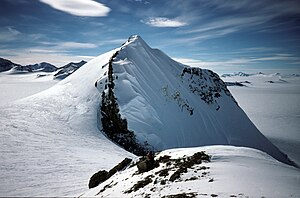Mount Jackson: Difference between revisions
No edit summary |
No edit summary |
||
| Line 26: | Line 26: | ||
{{reflist}} | {{reflist}} | ||
*{{BATgaz}} | *{{BATgaz}} | ||
Revision as of 11:04, 11 December 2017
| Mount Jackson | |
| British Antarctic Territory | |
|---|---|
 South-east of Mount Jackson ridge | |
| Summit: | 10,446 feet 71°22’60"S, 63°22’0"W |
Mount Jackson is a massive mountain that dominates the upland in the southern part of the Antarctic Peninsula. It rises to a majestic summit peak 10,446 feet above sea level on south and east, while the north flank is occupied by a vast cirque. It stands on the continent of Antarctica within the British Antarctic Territory.
In December 2017 the mountains of Palmer Land were resurveyed, raising Mount Jackson's summit from 10,007 feet to the newly measured 10,446 feet. At the same time though the recorded height of Mount Hope in the Eternity Range of Palmer Land was raised to 10,626 feet, which put it higher than Mount Jackson: until that measurement, Mount Jackson was believed to be the highest mountain in the territory.
With a prominence of 7,2175 feet above the surrounding land, in worldwide terms, Mount Jackson is listed as an "Ultra prominent peak".
Discovery and name
Mount Jackson was discovered by members of the United States Antarctic Service, 1939–41, in aerial flights and sighted by the ground survey party on the plateau.
The mountain was named by the United States Antarctic Service for Andrew Jackson, the seventh President of the United States, who signed the bill authorizing the United States Exploring Expedition, 1838–42, led by Lt. Charles Wilkes of the US Navy. Alternate names for the mountain include Mount Andrew Jackson and Mount Ernest Gruening.
First ascent
The first ascent of Mount Jackson was achieved by a team from the British Antarctic Survey: J C Cunningham (Leader), J L Gardner, (General Assistant) B Pimm Smith (Meteorologist) and D T Todd (General Assistant) reached the summit on 23 November 1964.[1]
References
- ↑ (1965) British activities in the Antarctic, 1963–64. Polar Record, 12 , pp 416-422 doi:10.1017/S0032247400054930